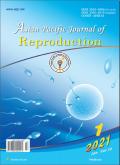东革阿里对家禽的壮阳作用
IF 0.6
Q4 REPRODUCTIVE BIOLOGY
引用次数: 1
摘要
目的:研究大叶茯苓对家禽的壮阳作用。方法:通过体外培养的TM3间质细胞和4只鸡的体外培养,研究睾丸激素(睾丸激素)的释放情况,每个胶囊10 mg,每天2次,连续50天。在后者的体内评估中,将处理后的鸡放归母鸡个体后,进一步测定交配行为,并解剖其睾丸和肝脏进行组织学检查。从家禽身上抽血评估诊断参数是否有任何变化。结果:在体外实验(TM3间质细胞)中,在培养72h内,黄颡虾能将睾酮水平提高到0.48 nmol/L,而未处理的对照组仅为0.18 nmol/L,即提高了170%。在体内试验中,与对照组(4.05±0.84)nmol/L的睾酮水平相比,给药鸡的睾酮水平呈(9.72±1.10)nmol/L的阳性升高,对照组睾酮水平为(9.72±1.10)nmol/L。在试验中观察到交配行为的总频率(拍打翅膀、摇动身体、啼叫和啄嘴)为23次,而对照鸡只有15次。与对照组相比,男性生殖器官的组织学检查提供了睾丸激素增加的证据,这是基于睾丸组织精管活动的可观察到的增加,而没有任何破坏性影响。在评估的9个诊断血液参数中,包括丙氨酸转氨酶、天冬氨酸转氨酶和谷氨酰转氨酶,与对照组相比,没有一个明显升高。肝脏的组织学改变并不严重,主要是局部、中度但可恢复的血管和小管阻塞和肿胀。结论:在体内和体外均能提高睾酮水平,且无急性毒性。本文章由计算机程序翻译,如有差异,请以英文原文为准。
Aphrodisiac potential of Polyalthia bullata (Tongkat Ali) in fowl
Objective: To study the aphrodisiac potential of Polyalthia (P.) bullata in fowl. Methods: In this study, testosterone, as an indicator of the aphrodisiac potential of P. bullata, was investigated for its release from TM3 Leydig cells grown in vitro and in 4 fowls given capsules containing P. bullata at a dose of 10 mg in each capsule twice a day, for 50 days. In the latter in vivo evaluation, mating behaviours were additionally determined after the treated fowls were released to the individual hens, and their testes and liver were dissected for histological examinations. Blood drawn from the fowls was assessed for any changes in diagnostic parameters. Results: In the in vitro test (TM3 Leydig cells), P. bullata was able to increase testosterone to 0.48 nmol/L within 72 h of incubation, compared to the untreated control with only 0.18 nmol/L, i.e., an increase of 170%. In the in vivo test, outcomes in the fowls dosed with P. bullata showed similar positive elevations of testosterone to (9.72±1.10) nmol/L in comparison to the controls that showed a level of only (4.05±0.84) nmol/L. Total frequencies of mating behaviours were observed (wing flapping, body shakes, crowing and beak pecking) to be 23 counts for the test compared to only 15 for the control fowls. Histological examination of the male reproductive organs provided evidence of testosterone boosting based on an observable increase in the activity at the seminiferous tubules of testis tissues without any damaging effects, compared to the controls. In the nine diagnostic blood parameters assessed, including alanine aminotransferase, aspartate aminotransferase, and gamma glutamyltransferase, none was remarkably elevated compared to the controls. The histological changes in the liver were not severe and mainly consisted of only localized moderate but recoverable obstructions and swellings of the vessels and tubules. Conclusions: P. bullata is able to boost testosterone both in vitro and in vivo, with no acute toxicities.
求助全文
通过发布文献求助,成功后即可免费获取论文全文。
去求助
来源期刊

Asian Pacific Journal of Reproduction
Veterinary-Veterinary (all)
CiteScore
1.70
自引率
0.00%
发文量
588
审稿时长
9 weeks
期刊介绍:
The journal will cover technical and clinical studies related to health, ethical and social issues in field of Gynecology and Obstetrics. Articles with clinical interest and implications will be given preference.
 求助内容:
求助内容: 应助结果提醒方式:
应助结果提醒方式:


